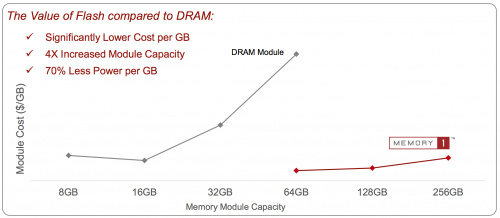I’ve written about Diablo Technologies in the past, and they’re been part of Tech Field Day and my other events. The company’s products have always blurred the line between storage and memory, placing flash chips on memory modules and leveraging the fast, low-latency memory channel rather than the PCI or SATA/SAS bus. Memory 1 does one better, delivering a true flash DIMM that works in virtually any server.

Memory Channel Storage and Memory Channel Memory
Diablo really wowed the storage world by bringing flash storage in a DRAM form factor to the memory channel. There, they delivered amazing performance: An order of magnitude lower latency than any other solution. And this was maximized by reducing the variability of latency seen on the PCI bus, let alone external storage solutions.
Memory Channel Storage, as Diablo calls this solution, is great for many applications but it has some limitations. For one, it requires special tweaks to the motherboard so the BIOS won’t try (and fail) to use this block flash capacity as regular memory. For another, it’s still block storage, complete with a LUN and (probably) a file system in the operating system.
Given the fact that Diablo had produced a DRAM form factor for NAND, the next logical step was making this flash appear as regular system memory, not storage. That’s Memory 1. In a way, it’s “Memory Channel Memory” though I’m glad no one is calling it that!
Diablo Memory 1
The physical product looks similar, and leverages the same technology, but the Memory 1 and MCS products are quite different in detail.
One major change is that Memory 1 no longer needs any special hardware or BIOS tweaks. The BIOS sees a few very large DIMMs and booths normally. Then a proprietary software driver starts, acting as an arbiter between the traditional RAM and Memory 1 flash. Diablo says most application execution happens in RAM, while in-memory caches are written to Memory 1. This makes it ideal for in-memory databases, caching solutions, and many web platforms but perhaps not for large, active applications. And the software will only work with Linux, Windows, and VMware initially.
Note that Memory 1 does not replace RAM in a system. You still need to buy some traditional RAM DIMMs. But you can buy a lot less (think 10:1 flash:RAM) and get a lot more.
The biggest change is simply what the product is. Memory 1 is memory; MCS is storage. Memory 1 looks like memory, acts like memory, and is accessed like memory. And it solves memory-related problems, like the fact that the biggest RAM DIMMs are much, much more expensive on a per-GB basis than smaller ones. Diablo isn’t talking pricing, but the graph above suggests that not only will Memory 1 be cheaper than the cheapest RAM, it’ll remain cheap even at large capacities.
And that’s really the killer app for this product: Too many purchase decisions are a delicate balance between RAM requirements and budgets. With Memory 1, buyers can simply buy as much RAM as they want (within reason) and not break the bank. No more buying too-big servers just for the DIMM slots or buying extra blades because you can’t get enough memory in one. And this should save tons of money when it comes to server acquisition as well as power.
Stephen’s Stance
Memory 1 is the next game-changer from Diablo. I’ve been very impressed by the company’s offerings in the past, and this is the logical next step for them. And it ought to be absolutely killer since it no longer requires special motherboard tweaks. I expect it’s going to be huge in the cloud datacenter.
Disclaimer: Diablo is a frequent Tech Field Day presenter and my company, Foskett Services, has done editorial work for them in the past, including a whitepaper written by yours truly.

Nice blog, thanks for the summary!